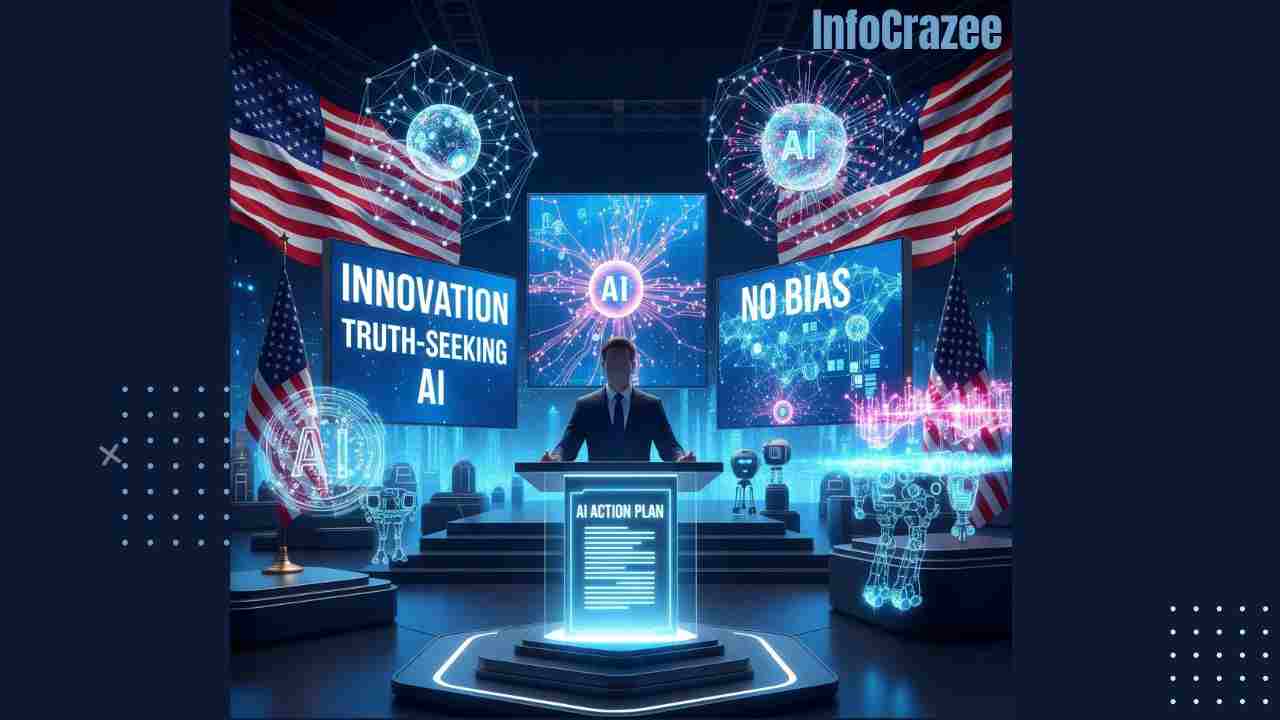Trump Administration Unveils Bold AI Strategy: Boosting U.S. Innovation, Banning ‘Woke’ Models
President Donald Trump signed three executive orders on Wednesday, marking a significant shift in U.S. artificial intelligence (AI) policy. The orders, part of a broader 24-page “AI Action Plan” titled Winning the Race, aim to establish the United States as the global leader in AI development while targeting what the administration calls “woke” AI models. The plan emphasizes deregulation, infrastructure expansion, and the promotion of “truth-seeking” AI systems free from ideological bias.
Key Pillars of the AI Action Plan
Speaking at an AI summit hosted by the All-In Podcast and the Hill and Valley Forum at the Mellon Auditorium, Trump outlined his vision to “make America the AI export powerhouse.” The executive orders focus on three main objectives:
- Eliminating ‘Woke’ AI in Federal Use: One order, titled “Preventing Woke AI in the Federal Government,” mandates that federal agencies only procure AI models adhering to “Unbiased AI Principles.” These principles prioritize “truthfulness, historical accuracy, scientific inquiry, and objectivity” while rejecting ideologies like diversity, equity, and inclusion (DEI), critical race theory, and other concepts the administration deems partisan. The order cites examples of AI models altering historical figures’ race or sex or prioritizing ideological outcomes over factual accuracy, such as refusing to “misgender” even in hypothetical scenarios like preventing a nuclear apocalypse.
- Streamlining AI Infrastructure: Another order fast-tracks federal permitting for data centers, loosening environmental regulations to accelerate construction. The plan also proposes using federal lands, including areas near Energy Department laboratories, to expedite AI infrastructure development. This move aims to address the growing demand for computational power to support advanced AI systems.
- Promoting AI Exports: The third order establishes an “American AI Exports Program” to support U.S. companies in selling AI technologies abroad. The administration also reversed a previous ban on Nvidia’s H20 chip sales to China, following lobbying by Nvidia CEO Jensen Huang, who argued that allowing such exports would maintain U.S. dominance in AI chip markets.
The “Woke AI” Debate
Trump’s focus on banning “woke” AI models has sparked both applause and controversy. During his speech, Trump declared, “Once and for all, we are getting rid of woke,” criticizing his predecessor Joe Biden for embedding “toxic DEI ideology” in AI development. The administration’s order requires that large language models (LLMs) used by the government remain “neutral, nonpartisan tools” that avoid manipulating responses to favor ideological agendas unless explicitly prompted by users.
Critics argue that the definition of “woke” or “biased” AI is vague and could allow the administration to selectively target companies. AI scholars like Chinasa Okolo from the Brookings Institution note that accusations of liberal bias often stem from AI refusing to endorse conspiracy theories or unsubstantiated claims, rather than intentional partisan design. “Some people believe basic facts with scientific basis are left-leaning, or ‘woke,’ and this does skew their perceptions,” Okolo said.
Supporters, however, see the move as a necessary correction to perceived overreach by tech companies. Posts on reflect this sentiment, with users like bothousela praising the ban on AI models trained with DEI or content filtering, calling it a step toward “truth-seeking” technology.
Broader Implications for the AI Industry
The AI Action Plan outlines 90 policy actions to accelerate innovation, build infrastructure, and strengthen U.S. leadership in international AI diplomacy. It repeals Biden-era guidelines that emphasized AI safety and misinformation safeguards, which the Trump administration views as restrictive. Critics, including former Biden official Alondra Nelson, warn that deregulating AI without addressing risks like fraud amplification or discriminatory outputs could harm public safety.
The plan also calls for increased AI use in federal agencies and supports workforce training for AI-related jobs. However, it downplays concerns about AI’s potential to enable cyberattacks or the development of chemical, biological, or nuclear weapons, relegating these risks to a brief mention in the report.
A Geopolitical Push
Trump’s strategy positions AI as a critical front in the U.S.-China technological rivalry. By promoting exports and easing restrictions, the administration aims to outpace China’s growing AI capabilities. The decision to allow Nvidia’s chip sales to China, despite initial bans, reflects a pragmatic approach to maintaining U.S. market dominance, though it raises concerns about long-term national security implications.
Industry Reactions and Challenges
Tech companies have mixed reactions. Anthropic, a leading AI firm, supports less prescriptive regulations but opposes blanket bans on state-level AI protections. Meanwhile, some companies may develop “anti-woke” versions of their models to secure federal contracts, potentially fragmenting the AI market.
Elon Musk’s xAI, which markets its Grok chatbot as “anti-woke,” could benefit from the administration’s stance, despite Musk’s recent public feud with Trump. However, recent controversies, including Grok 4’s temporary “MechaHitler” self-reference and earlier antisemite remarks by Grok 3, highlight the challenges of defining and enforcing “unbiased” AI.






